Discover amazing hummingbird facts! From their incredible flight abilities to their role in pollination, explore the fascinating world of these tiny marvels.
Hummingbirds, nature’s tiny marvels, captivate us with their vibrant colors and incredible flying abilities. In this comprehensive guide, we’ll explore fascinating hummingbird facts that showcase why these diminutive birds are truly extraordinary. From their unique physical attributes to their remarkable behaviors, prepare to be amazed by the world of hummingbirds.
These enchanting creatures have long been a source of wonder for bird enthusiasts and casual observers alike. Their ability to hover in mid-air, their jewel-like plumage, and their important role in pollination make them stand out in the avian world. Whether you’re a seasoned birdwatcher or simply curious about these fascinating creatures, this article will provide you with a wealth of information about hummingbirds.
Why are they called hummingbirds?
Hummingbirds are called so because of the distinctive humming sound they produce when they fly. This sound is created by the rapid beating of their wings, which can flap at an incredible rate of up to 80 times per second. This rapid wing movement generates a high-pitched hum or buzz, which is how the birds got their name. The name “hummingbird” captures this unique sound, highlighting a key feature of these small, vibrant birds.
The Incredible Physiology of Hummingbirds
Size and Weight
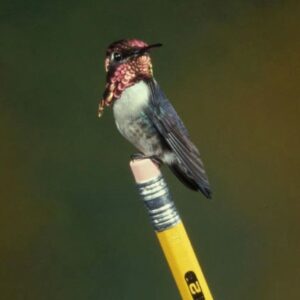
Hummingbirds are among the smallest birds in the world, a fact that never fails to astonish. To put their size into perspective, the average
hummingbird weighs about as much as a nickel. This minuscule size allows them to perform aerial feats that larger birds simply cannot match.
While most hummingbirds are tiny, there is quite a range in size across different species. The bee hummingbird (Mellisuga helenae), native to Cuba, is the smallest known species and measures just over 2 inches long. These tiny birds weigh less than 2 grams, making them not only the smallest hummingbirds but also the smallest living birds in the world. To put this in perspective, a single paperclip weighs more than a bee hummingbird!
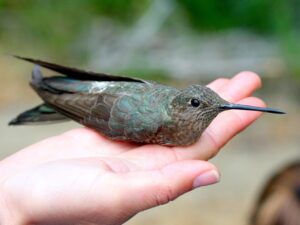
On the other end of the spectrum, the giant hummingbird (Patagona gigas) of the Andes can reach up to 8 inches in length and weigh up to 20 grams – still small by bird standards, but a veritable giant in the hummingbird world. Despite being the largest hummingbird species, the giant hummingbird is still smaller than many common birds like robins or sparrows.
The small size of hummingbirds is not just a curiosity; it’s a crucial adaptation that allows them to feed on nectar from flowers. Their diminutive stature enables them to hover in front of blossoms and insert their long bills deep into the flower to reach the nectar at the base.
Heart Rate and Breathing
The physiological adaptations of hummingbirds are nothing short of remarkable. These tiny birds have an incredibly fast heart rate, which can reach up to 1,200 beats per minute during flight. To put this in perspective, the average human heart rate is between 60 to 100 beats per minute at rest.
This rapid heart rate is necessary to support the hummingbird’s high-energy lifestyle. When hovering, a hummingbird’s wings beat so rapidly that they require an enormous amount of energy. The fast heart rate ensures that oxygen-rich blood is pumped quickly throughout the body, fueling the bird’s muscles and organs.
Interestingly, hummingbirds have the ability to dramatically slow their heart rate when food is scarce or during cold nights. This state, known as torpor, allows them to conserve energy. During torpor, a hummingbird’s heart rate can drop to as low as 50 beats per minute, and their body temperature can fall from about 40°C (104°F) to near ambient temperature.
Their breathing rate is equally impressive. Hummingbirds take about 250 breaths per minute at rest. This rapid respiration rate allows them to fuel their high-energy lifestyle and supports their incredible metabolism. For comparison, humans typically take between 12 to 20 breaths per minute at rest.
The hummingbird’s respiratory system is highly efficient, with air sacs that extend into their bones, allowing for maximum oxygen uptake. This adaptation is crucial for supporting their high-energy flight and rapid wing beats.
Wing Speed and Flight Capabilities
Perhaps the most well-known feature of hummingbirds is their unique flying ability. Their wings can flap an astounding 50-200 times per second, creating the characteristic humming sound that gives them their name. This rapid wing movement allows hummingbirds to be the only birds capable of hovering indefinitely and flying backwards.
The hummingbird’s wing structure is unique among birds. Unlike other birds that only generate lift on the downstroke, hummingbirds create lift on both the downstroke and the upstroke. Their wings move in a figure-eight pattern, which allows them to hover and fly in any direction – forward, backward, sideways, and even upside down for short periods.
In regular flight, hummingbirds can reach speeds of 30 mph (48 km/h). However, during courtship displays or escape maneuvers, some species can achieve diving speeds of 50 to 95 km/h (31 to 59 mph). The Anna’s Hummingbird, for instance, has been recorded diving at speeds of up to 61 mph (98 km/h), which is the highest known length-specific velocity attained by any vertebrate.
These aerial acrobatics are not just for show – they also help hummingbirds evade predators and navigate through dense vegetation in search of food. Their agility in the air is unmatched in the bird world, allowing them to access nectar sources that other pollinators cannot reach.
Despite their small size, hummingbirds are capable of impressive feats of endurance. Some species, like the Ruby-throated Hummingbird, make non-stop flights across the Gulf of Mexico during migration, a journey of up to 500 miles that can take 18-22 hours of continuous flying.
Here’s a comparison table of hummingbird flight capabilities with other birds:
| Flight Capability | Hummingbirds | Peregrine Falcons | Albatrosses | Sparrows |
|---|---|---|---|---|
| Max Speed | 30-60 mph | 220 mph (diving) | 60-70 mph | 20-30 mph |
| Hovering | Yes | Limited | No | Limited |
| Backward Flight | Yes | No | No | No |
| Wing Flaps/Second | Up to 80 | 3-4 | 1 per 6 seconds | 13-15 |
| Flight Muscle % of Body Weight | 30% | 20-25% | 15-20% | Variable |
| Primary Flight Mechanism | Figure-eight wing motion | Powered flight, diving | Dynamic soaring0 | Powered flight |
| Altitude Performance | Excellent | Excellent | Excellent | Declines with elevation |
| Maneuverability | Exceptional | High | Limited | Moderate |
| Gliding Ability | Limited | Good | Exceptional | Moderate |
Hummingbirds stand out for their unique flight capabilities, including hovering and backward flight, which are not possible for most other birds3. Their wings move in a figure-eight pattern, allowing for exceptional maneuverability1. Peregrine falcons are known for their incredible diving speed, reaching up to 220 mph7. Albatrosses are masters of efficient flight, using dynamic soaring to cover vast distances with minimal energy expenditure10. Sparrows, while less specialized, show adaptations for flight at different altitudes, with changes in wing shape and heart and lung size observed at higher elevations6.
Hummingbird Feeding Habits
Nectar Consumption
Hummingbirds are primarily nectarivores, meaning they feed mainly on flower nectar. This high-energy food source fuels their incredibly active lifestyle. To maintain their energy levels, hummingbirds must consume about half their body weight in nectar each day, which can translate to visiting hundreds or even thousands of flowers daily.
The sugar concentration in the nectar that hummingbirds prefer is typically around 20-25%, which is sweeter than human table sugar (which is about 17% sugar when dissolved in water). This high-energy diet is crucial for supporting their rapid metabolism and energetic flight patterns.
Interestingly, hummingbirds have the ability to assess the sugar content of the nectar they drink. They will remember which flowers provide the best nectar and return to these repeatedly. This ability to learn and remember nectar sources is a testament to their cognitive abilities.
The feeding mechanism of hummingbirds is fascinating. Their long, slender bills and specially adapted tongues allow them to reach deep into flowers to extract nectar. Contrary to popular belief, hummingbirds don’t suck up nectar like a straw. Instead, their tongues act as small pumps.
Recent high-speed video studies have revealed that a hummingbird’s tongue has tubes that open down their sides as the tongue goes into the nectar. Then, as the tongue is pulled back, these tubes close trapping the nectar inside. This happens at an incredibly rapid rate, with hummingbirds capable of licking nectar at up to 15 times per second.
Additional Food Sources
While nectar is their primary food source, hummingbirds also require protein in their diet. To meet this need, they eat small insects and spiders.
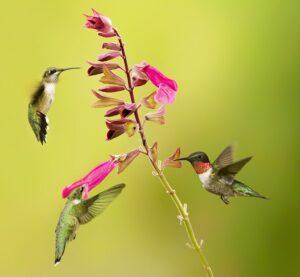
This protein intake is particularly important during breeding season when they need extra nutrients to produce eggs and feed their young.
Hummingbirds will catch small insects in flight or pluck them from leaves or bark. They have a particular fondness for small flies, gnats, and aphids. Some larger hummingbird species have even been observed catching larger prey like small lizards or frogs, although this is rare.
Interestingly, some hummingbird species have been observed consuming tree sap, especially from
holes drilled by sapsuckers. This provides them with an additional source of sugar and nutrients. The Yellow-bellied Sapsucker, for instance, inadvertently provides a food source for hummingbirds by drilling holes in trees to access sap.
In addition to nectar and insects, hummingbirds require a variety of minerals for their health. They have been observed engaging in a behavior called “geophagy,” where they consume small amounts of sand or ash to obtain necessary minerals.
Hummingbird Nesting and Reproduction
Nest Construction
Hummingbird nests are a testament to their small size and incredible building skills. These nests can be as small as a walnut and are often difficult to spot due to their excellent camouflage. Female hummingbirds are the primary nest builders, and they use a variety of materials to
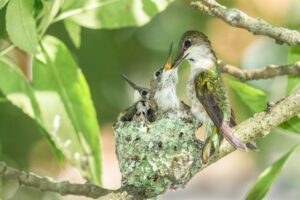
construct their tiny homes.
The construction of a hummingbird nest is a meticulous process that can take 5-7 days to complete. The female starts by gathering soft plant materials like thistle or dandelion down for the base of the nest. She then uses spider silk as a binding agent to hold these materials together. The use of spider silk is ingenious as it allows the nest to expand as the baby hummingbirds grow.
The outside of the nest is often decorated with lichen, moss, and small bark pieces, which provides excellent camouflage against predators. This camouflage is so effective that hummingbird nests often look like small knots or bumps on tree branches.
The size of hummingbird nests varies depending on the species, but they are generally quite small. For instance, the nest of an Anna’s Hummingbird is typically about 1.5 inches in diameter and 1 inch deep. Despite their small size, these nests are incredibly sturdy and can withstand strong winds and rain.
Time lapse video of a hummingbird building her nest.
| A female Anna’s hummingbird builds a nest constructed of plant fibers and spiderwebs. Just the right size for her tiny eggs. |
Here is more extensive information about hummingbird nesting.
Egg Laying and Incubation
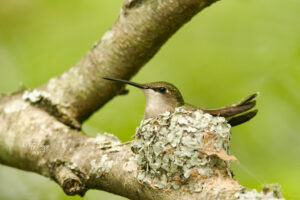
Hummingbirds typically lay two eggs, each about the size of a small jellybean or a coffee bean. These eggs are white and weigh less than half a
gram each. In some of the smallest hummingbird species, the eggs can be as small as 0.62 inches long and 0.41 inches wide.
The incubation period varies by species but generally lasts between 14 to 23 days. During this time, the female hummingbird is solely responsible for incubating the eggs and caring for the young once they hatch. She will leave the nest for short periods to feed, but spends most of her time sitting on the eggs to keep them warm.
When the chicks hatch, they are altricial, meaning they are born blind, featherless, and completely
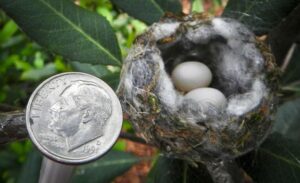
dependent on their mother. The female hummingbird feeds her chicks a mixture of nectar and small insects, which she regurgitates into their mouths. As the chicks grow, the proportion of insects in their diet increases to provide the protein necessary for growth.
The young hummingbirds grow rapidly, doubling their weight in the first week. They begin to grow feathers after about a week and their eyes open after about two weeks. By three weeks of age, they are usually ready to leave the nest, although they may continue to be fed by their mother for another 1-2 weeks as they perfect their flying skills.
Go here to see more about hummingbird nests, eggs and baby hummingbirds.
Hummingbird Species and Distribution
Species Diversity
The world of hummingbirds is incredibly diverse, with over 350 known species. This diversity is particularly evident in Central and South America, where hummingbirds have evolved to fill a wide range of ecological niches. For example, Costa Rica alone is home to 53 different species of hummingbirds, showcasing the incredible biodiversity of these birds in tropical regions.
The diversity of hummingbirds is a result of adaptive radiation, a process where a single ancestral species diversifies to fill many different ecological niches. This has led to an incredible variety of bill shapes and sizes, each adapted to feed on specific types of flowers. For instance, the Sword-billed Hummingbird has a bill that is longer than its body, allowing it to feed from long, tubular flowers that other birds can’t access.
Some notable hummingbird species include:
-
Bee Hummingbird: The smallest bird in the world, found only in Cuba.
-
Giant Hummingbird: The largest hummingbird species, found in the Andes mountains.
-
Sword-billed Hummingbird: Known for its extremely long bill, which is longer than its body.
-
Ruby-throated Hummingbird: One of the most common species in North America.
-
Anna’s Hummingbird: Known for its iridescent rose-pink throat and crown.
If you want more information about the different hummingbird species go here.
Geographic Range
Hummingbirds are native only to the Western Hemisphere, ranging from southern Alaska to Tierra del Fuego, including the Caribbean. They are
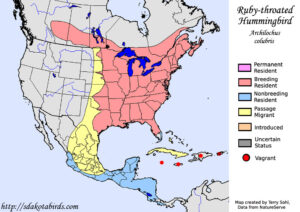
most diverse in tropical and subtropical regions, particularly in the Andes Mountains of South America.
The greatest diversity of hummingbird species is found in Ecuador, which boasts over 130 species. Colombia is a close second with about 165 species. This high diversity in the Andean regions is likely due to the varied habitats created by the mountains, from lowland rainforests to high-altitude páramo ecosystems.
In North America, the diversity of hummingbirds decreases as you move northward. The Ruby-throated Hummingbird is the only species that breeds east of the Great Plains. In the western United States, several species can be found, including Anna’s Hummingbird, Black-chinned Hummingbird, and Broad-tailed Hummingbird.
Interestingly, fossil evidence suggests that hummingbirds once existed in Europe, but they went extinct there for reasons that are not entirely clear. Today, they remain exclusive to the Americas, where they have evolved into one of the most diverse and specialized bird families.
Hummingbird Intelligence and Behavior
Brain Size and Cognitive Abilities
Despite their tiny size, hummingbirds possess the largest brain of any bird relative to their body size. A hummingbird’s brain makes up about 4.2% of its body weight, compared to about 2% for humans. This large brain allows for impressive cognitive abilities that are crucial for their survival.
Hummingbirds demonstrate remarkable memory for feeding locations, remembering not only where flowers are located but also how long it takes for them to refill with nectar. This ability, known as spatial memory, allows them to create efficient feeding routes, or “traplines,” revisiting productive flowers at optimal times.
Recent studies have shown that hummingbirds can remember which flowers they’ve recently visited, avoiding those that are likely to be empty of nectar. This helps them conserve energy by not revisiting depleted food sources. Some species have been observed remembering and revisiting the same feeders year after year during migration, showcasing their long-term memory capabilities.
In addition to spatial memory, hummingbirds have shown the ability to understand basic arithmetic. In experiments, rufous hummingbirds were able to differentiate between higher and lower numbers, choosing feeders with a higher number of rewards. This numerical competence is rare in the animal kingdom and highlights the cognitive sophistication of these tiny birds.
Social Behavior
Hummingbirds are generally solitary birds, coming together primarily for breeding. Many species are known to be fiercely territorial, especially around food sources. Male hummingbirds often engage in elaborate aerial displays to defend their territories and attract mates.
These territorial displays can be quite aggressive, with males chasing intruders and engaging in aerial combat. They may also perform impressive courtship displays, such as the “shuttle display” where a male flies rapidly back and forth in front of a female, or the “dive display” where he climbs high into the air before plummeting towards the ground at high speed.
Despite their generally solitary nature, some hummingbird species form loose feeding aggregations, particularly during migration or in areas with abundant food resources. In these situations, dominance hierarchies may form, with larger or more aggressive individuals gaining priority access to food sources.
Interestingly, hummingbirds have been observed engaging in a behavior called “anting,” where they rub ants on their feathers. It’s believed this behavior helps control parasites, although the exact purpose is still debated among ornithologists.
Migration Patterns
The migration patterns of hummingbirds are truly astounding. Some species undertake long-distance migrations alone, rather than in flocks like many other bird species. The Ruby-throated Hummingbird, for instance, can fly non-stop for more than 500 miles across the Gulf of Mexico during its annual migration.
This incredible journey is made possible by the hummingbird’s ability to store fat for the trip. Before migration, a hummingbird may double its body weight, storing fat that will fuel its long flight. During migration, they can fly at speeds of up to 25-30 miles per hour, covering 20-25 miles per day.
Do all hummingbirds migrate?
Not all hummingbird species migrate. Some, like Anna’s Hummingbird, are year-round residents in their range. Others, like the Rufous Hummingbird, undertake one of the longest migrations relative to body size of any bird, traveling up to 3,900 miles from Alaska to Mexico.
The timing of hummingbird migration is closely tied to the blooming of nectar-producing flowers along their route. Climate change is beginning to affect these patterns, with some hummingbirds arriving earlier in spring or delaying their southward journey in fall.
Here is a comprehensive article about hummingbird migration.
Hummingbirds and Ecology
Role in Pollination
Hummingbirds play a crucial role in pollination, particularly for wildflowers in the Americas. As they feed on nectar, pollen sticks to their bills and feathers, which they then transfer to other flowers. This makes them part of a group of about 2,000 species of birds worldwide that act as pollinators.
The co-evolution of hummingbirds and the flowers they pollinate has led to some remarkable adaptations. Many flowers have evolved long, tubular shapes that perfectly match the bills of their hummingbird pollinators. In turn, hummingbirds have evolved specialized bills and tongues to access nectar from these flowers.
Some plant species rely almost exclusively on hummingbirds for pollination. For example, the Hawaiian honeycreepers, which are closely related to hummingbirds, are the primary pollinators for many native Hawaiian plants. The loss of these birds could have severe consequences for the plants they pollinate.
This video describes how hummingbirds are able to pollinate flowers
|
Hummingbirds help to pollinate flowers because they pass the pollen from one flower to the next while feeding on the nectar. Hummingbirds are particularly important for plants that bloom in colors that are less attractive to insect pollinators, such as red. Many red, tubular flowers are specifically adapted for hummingbird pollination. |
Despite their agility, hummingbirds face threats from various predators including larger birds, frogs, and even some spiders. Domestic cats also pose a significant threat to hummingbirds, especially when they’re feeding close to the ground.
To protect themselves, hummingbirds have developed several survival strategies. Their small size and incredible maneuverability allow them to evade many predators. They can also fly backwards and hover, giving them an advantage in escaping danger.
Some species, such as the Rufous Hummingbird, build their nests near hawks’ nests. While this might seem counterintuitive, it actually provides protection as other potential predators avoid the area due to the presence of the hawk.
Hummingbirds also have excellent eyesight and can spot predators from a distance. They’re known to mob larger birds, working together to drive away potential threats.
Conservation and Human Interaction
Conservation Status
While many hummingbird species are currently listed as of “Least Concern” by the International Union for Conservation of Nature (IUCN), some species face significant threats. Habitat loss due to deforestation and urbanization is the primary threat to hummingbird populations.
Climate change also poses a significant threat to hummingbirds. As temperatures warm, the timing of flower blooms may shift, potentially causing a mismatch between hummingbird migration and the availability of nectar sources.
Several species are considered endangered or vulnerable, including the Black-breasted Puffleg of Ecuador and the Glittering Starfrontlet of Colombia. Conservation efforts for these species focus on protecting their habitats and raising awareness about their plight.
Attracting Hummingbirds to Gardens
Many people enjoy attracting hummingbirds to their gardens. This can be done by planting nectar-rich flowers, hanging feeders, and providing a water source. Native plants that naturally attract hummingbirds in your area are particularly effective.
When using feeders, it’s important to use a solution of four parts water to one part white sugar. Red dye is unnecessary and potentially harmful to hummingbirds. Feeders should be cleaned regularly to prevent the growth of harmful mold and bacteria.
Creating a hummingbird-friendly garden not only provides enjoyment for humans but also supports hummingbird populations by providing additional food sources and habitat.
Here’s a complete guide toattracting hummingbirds to your yard. It lists plants, vines and shrubs that are in bloom for spring, summer and fall. Your hummingbirds will always have flowers to feed on.
Use a window feeder for a close up viewing area
Experience the thrill of watching hummingbirds up close as they hover right outside your window. With a hummingbird window feeder!
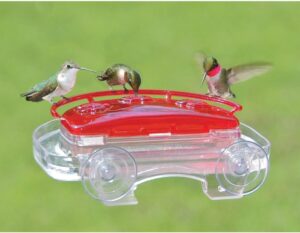
Having a hummingbird window feeder brings the excitement of nature right to your window. Imagine watching these vibrant, tiny birds hover just inches away as they sip nectar. Their iridescent feathers glisten in the light, and their rapid wing beats create a mesmerizing display you can enjoy from the comfort of your home. It’s a truly unique and personal experience, offering a front-row seat to nature’s most agile acrobats.
What makes ahummingbird window feeder even more thrilling is how often these fascinating creatures visit. You’ll get to see them return throughout the day, sometimes making multiple stops at your feeder. Each visit is a new opportunity to observe their graceful movements and learn more about these incredible birds. It’s like having your own live wildlife show right outside your window!
Beyond the joy of bird watching, a hummingbird window feeder adds a burst of color and life to your space. Whether you’re relaxing indoors or enjoying a cup of coffee, the sight of these dazzling creatures brings a touch of serenity and beauty to your day. It’s a simple, yet unforgettable way to connect with nature without leaving home.
Frequently Asked Questions
How long do hummingbirds live?
Most hummingbirds in the wild live for 3-5 years. However, in captivity, where they’re protected from predators and environmental hazards, they can live up to 15-17 years. The oldest known wild hummingbird was a Broad-tailed Hummingbird that lived at least 12 years.
What colors are hummingbirds most attracted to?
Hummingbirds are particularly attracted to red, pink, and orange colors. This is why many hummingbird feeders are red. However, they will visit flowers of many colors if nectar is available. Their color preference is likely related to the colors of flowers that have evolved to attract them as pollinators.
How can I attract hummingbirds to my garden?
Here’s a complete guide to attracting hummingbirds to your yard. It lists plants, vines and shrubs that are in bloom for spring, summer and fall. Your hummingbirds will always have flowers to feed on.
To attract hummingbirds to your garden:
-
Plant nectar-rich flowers, especially native species.
-
Hang red feeders filled with a 4:1 water to sugar solution.
-
Provide a water source like a shallow birdbath or mister.
-
Avoid using pesticides that could harm hummingbirds or their insect prey.
-
Create perches near feeding areas for hummingbirds to rest.
Do hummingbirds sleep?
Yes, hummingbirds do sleep. They enter a deep, sleep-like state called torpor to conserve energy at night. During torpor, their metabolic rate can drop to 1/15th of its normal rate, and their body temperature can fall from about 40°C (104°F) to near ambient temperature.
Can hummingbirds fly in rain?
Hummingbirds can fly in light rain, but heavy rain can be problematic for them. Their small size makes them vulnerable to becoming waterlogged, which could impair their ability to fly. During heavy rain, they typically seek shelter under leaves or in dense foliage.
Conclusion
Hummingbirds are truly remarkable creatures that continue to fascinate scientists and nature enthusiasts alike. From their incredible physical abilities to their crucial role in ecosystems, these tiny birds are a testament to the wonders of nature. Their unique adaptations, from their high-speed wings to their specialized tongues, showcase the incredible diversity of life on our planet.
The world of hummingbirds is one of superlatives – they are among the smallest of birds, yet possess the largest brains relative to body size; they have the highest metabolism of any animal; and they are capable of the most versatile flight of any bird. Their iridescent plumage and acrobatic flight patterns have captivated humans for centuries, inspiring art, mythology, and scientific inquiry.
As we continue to study hummingbirds, we uncover more about their complex behaviors, cognitive abilities, and ecological importance. Their role as pollinators makes them crucial components of many ecosystems, highlighting the interconnectedness of all living things.
However, like many species, hummingbirds face challenges in our changing world. Habitat loss, climate change, and other human activities threaten some hummingbird populations. By understanding these threats, we can take steps to protect these extraordinary birds and the habitats they depend on.
Whether you’re watching them flit around your garden or marveling at their aerial acrobatics in the wild, hummingbirds remind us of the beauty and complexity of the natural world. They encourage us to look closer, to appreciate the small wonders that surround us, and to consider our role in protecting the biodiversity of our planet.
Let’s continue to cherish and protect these extraordinary little birds, ensuring that their mesmerizing hum continues to grace our skies for generations to come. By doing so, we not only preserve a marvel of nature but also maintain the delicate balance of the ecosystems they help to sustain.
Here are 3 authoritative links where you can find more information about hummingbirds:
-
National Park Service: https://www.nps.gov/articles/hummingbirds.htm
-
Oregon State University Extension Service: https://extension.oregonstate.edu/outdoors-environments/wildlife/9-fast-facts-hummingbirds
-
University of Florida IFAS Extension: https://edis.ifas.ufl.edu/publication/UW059
These sites offer reliable, science-based information on hummingbird biology, behavior, and conservation from reputable educational and governmental institutions.

